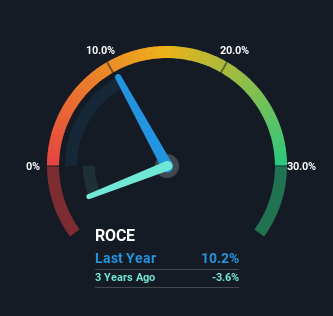- United States
- /
- Hospitality
- /
- NasdaqGS:WYNN
Here's What To Make Of Wynn Resorts' (NASDAQ:WYNN) Decelerating Rates Of Return
What are the early trends we should look for to identify a stock that could multiply in value over the long term? In a perfect world, we'd like to see a company investing more capital into its business and ideally the returns earned from that capital are also increasing. Basically this means that a company has profitable initiatives that it can continue to reinvest in, which is a trait of a compounding machine. Although, when we looked at Wynn Resorts (NASDAQ:WYNN), it didn't seem to tick all of these boxes.
Understanding Return On Capital Employed (ROCE)
For those that aren't sure what ROCE is, it measures the amount of pre-tax profits a company can generate from the capital employed in its business. Analysts use this formula to calculate it for Wynn Resorts:
Return on Capital Employed = Earnings Before Interest and Tax (EBIT) ÷ (Total Assets - Current Liabilities)
0.10 = US$1.2b ÷ (US$14b - US$2.7b) (Based on the trailing twelve months to September 2024).
So, Wynn Resorts has an ROCE of 10%. That's a relatively normal return on capital, and it's around the 9.1% generated by the Hospitality industry.
View our latest analysis for Wynn Resorts

Above you can see how the current ROCE for Wynn Resorts compares to its prior returns on capital, but there's only so much you can tell from the past. If you're interested, you can view the analysts predictions in our free analyst report for Wynn Resorts .
How Are Returns Trending?
Over the past five years, Wynn Resorts' ROCE and capital employed have both remained mostly flat. This tells us the company isn't reinvesting in itself, so it's plausible that it's past the growth phase. With that in mind, unless investment picks up again in the future, we wouldn't expect Wynn Resorts to be a multi-bagger going forward. With fewer investment opportunities, it makes sense that Wynn Resorts has been paying out a decent 54% of its earnings to shareholders. Given the business isn't reinvesting in itself, it makes sense to distribute a portion of earnings among shareholders.
What We Can Learn From Wynn Resorts' ROCE
In a nutshell, Wynn Resorts has been trudging along with the same returns from the same amount of capital over the last five years. Since the stock has declined 42% over the last five years, investors may not be too optimistic on this trend improving either. On the whole, we aren't too inspired by the underlying trends and we think there may be better chances of finding a multi-bagger elsewhere.
Since virtually every company faces some risks, it's worth knowing what they are, and we've spotted 2 warning signs for Wynn Resorts (of which 1 makes us a bit uncomfortable!) that you should know about.
For those who like to invest in solid companies, check out this free list of companies with solid balance sheets and high returns on equity.
Valuation is complex, but we're here to simplify it.
Discover if Wynn Resorts might be undervalued or overvalued with our detailed analysis, featuring fair value estimates, potential risks, dividends, insider trades, and its financial condition.
Access Free AnalysisHave feedback on this article? Concerned about the content? Get in touch with us directly. Alternatively, email editorial-team (at) simplywallst.com.
This article by Simply Wall St is general in nature. We provide commentary based on historical data and analyst forecasts only using an unbiased methodology and our articles are not intended to be financial advice. It does not constitute a recommendation to buy or sell any stock, and does not take account of your objectives, or your financial situation. We aim to bring you long-term focused analysis driven by fundamental data. Note that our analysis may not factor in the latest price-sensitive company announcements or qualitative material. Simply Wall St has no position in any stocks mentioned.
About NasdaqGS:WYNN
Low risk with limited growth.
Similar Companies
Market Insights
Community Narratives



